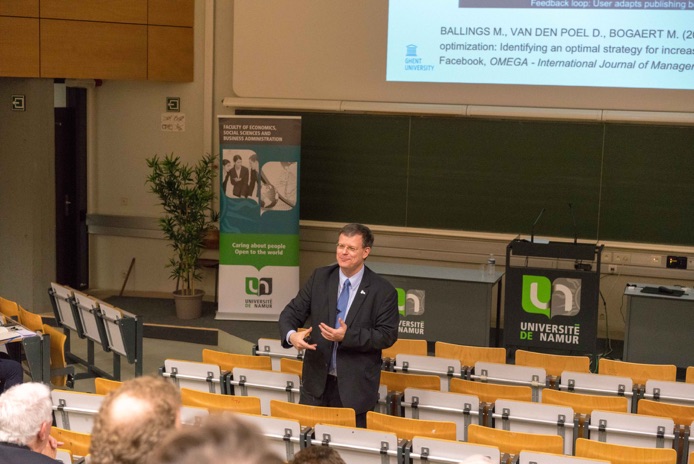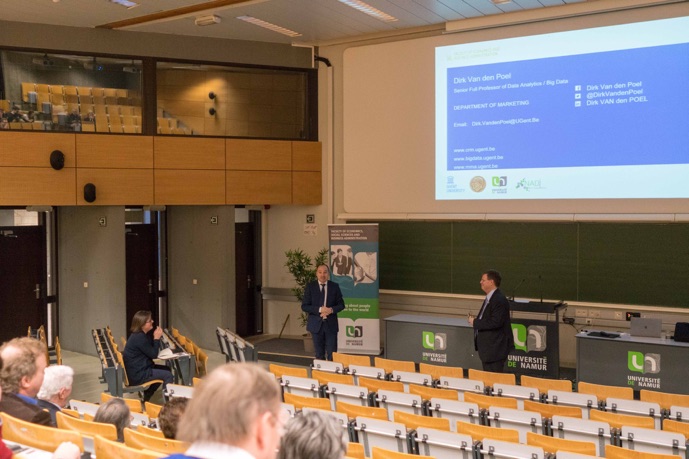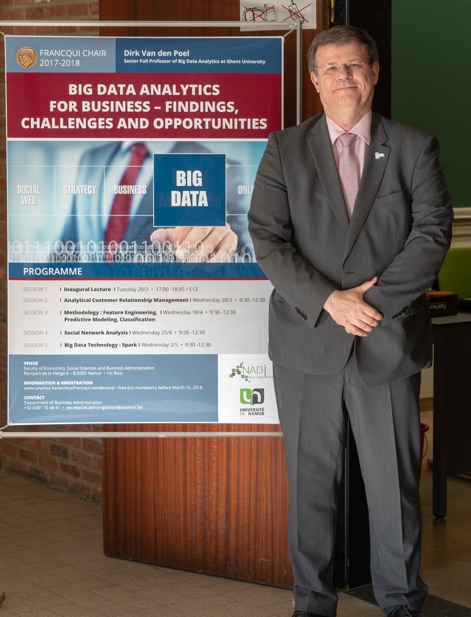Francqui Chair awarded to Prof. Dr. Dirk Van den Poel on Big Data Analytics

To honor his pioneering role in Big Data Analytics in Belgium the University of Namur awarded a Francqui Chair to Prof. Dr. Dirk Van den Poel (@dirkvandenpoel). The Francqui Chair consists of five lectures in total. 100+ attendees confirmed that it is a very hot topic also in industry. The inaugural lecture provided an introduction to Data Analytics for Business, which includes descriptive, predictive and prescriptive analytics as well as a brief intro into Big Data. The increasing availability of different kinds of data allows for improvements to predictive models: audio, images, video, network data, … . Next, he illustrated how Big Data Analytics improves business results. Examples in the realm of analytical Customer Relationship Management, credit scoring, design of optimal retail networks, human resources, and the interface with logistics were provided. He also discussed the many challenges.
Tuesday, 20 March 2018

Session Two is titled “Analytical Customer Relationship Management.” Analytical CRM (Customer Relationship Management) is about modeling the dynamics of the customer list: 1. customer acquisition, 2. churn, 3. upsell/cross-sell, and 4. win-back modeling. He discusses all four aspects in detail. E.g., in customer acquisition, we want to predict whether a prospect will have a high probability of becoming a customer even before contacting the person or business. But customer management is continuing to change (from transaction to relationship), now with a customer engagement orientation.
Session Three is a methodological session. Prof. Dr. Dirk Van den Poel discusses different techniques for predictive modeling. One of the most underappreciated activities in the entire modeling process (e.g., CRISP-DM) is compiling a list of predictors, also known as “Feature Engineering”. In general, investing additional efforts in collecting data to build better features is more important than looking for the best predictive model. Moreover, he discusses how to identify the most valuable features. He wraps up the session by discussing how Deep Learning might revolutionize feature engineering.

Session Four is about Social Network Analysis. SNA is the process of investigating social structures through the use of networks and graph theory. In an ever-increasing competitive environment, any source of additional data may lead to a competitive advantage. Today’s omnipresence of social media provides marketers with a great source of network data. What sensors are doing for electronic data capture, social media are doing for (inter)personal interactions. In networks such as Facebook, Twitter, Instagram, Snapchat, Pinterest opinion leaders self-identify themselves.
Finally, he illustrates the concepts with R packages for SNA: igraph and statnet.


Session Five is about Big Data Technology: Spark. With the increasing realization that Moore’s law is slowing down or even coming to a halt, a new computing paradigm is needed. To cope with today’s huge data volumes, we move from single-threaded to parallel computing in Big Data. Several alternative open-source middleware software projects enjoy increasing popularity. He focuses on Apache Spark in this session because of its Spark SQL and machine learning components. He discusses the concept of pipelines. Moreover, streaming analytics in Spark Streaming (as opposed to traditional batch analytics) will be discussed.


